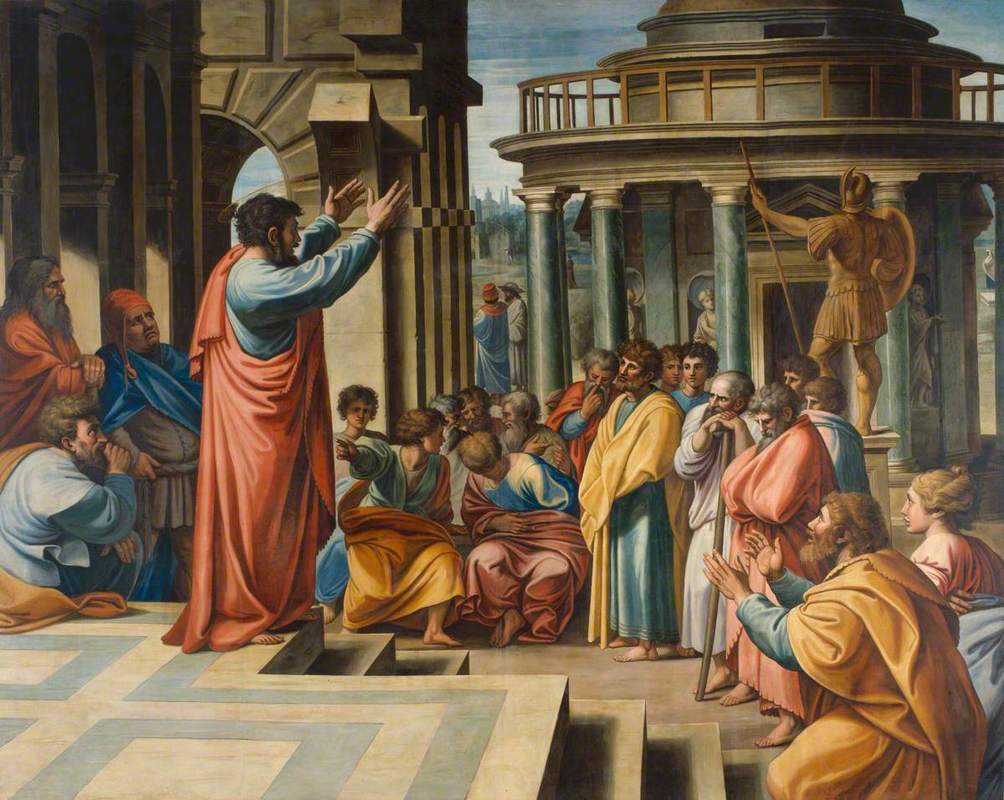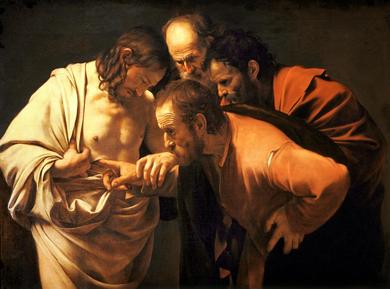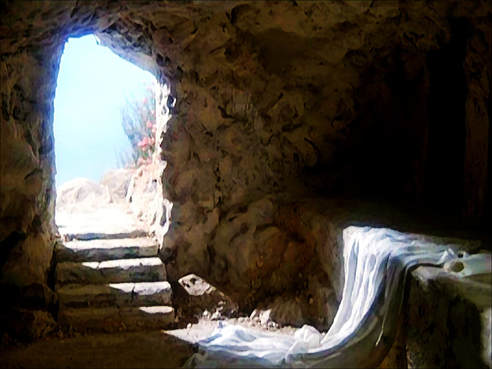|
4/29/2019 1 Comment Article IV: The ResurrectionPaul at the Aeropagus in Athens, Thornhill, James, 1675/1676-1734 Historical Fact III - The Conversion of the GentilesThe third historical fact that demands an explanation is the sudden rise of Christianity in the mid-first century. Why did it come into existence? What caused this movement to begin? Some of the most skeptical scholars recognize that Christianity arose because the earliest disciples sincerely believed that God raised Jesus from the dead.
The third historical fact, then, is the sudden and surprising birth of Christianity and its subsequent spread to the ends of the earth. To explain this third fact, we need to see the Resurrection through the New Testament writings, as the fulfillment of Jewish scripture. Then he opened their minds to understand the scriptures, and said to them, "Thus it is written, that the Christ should suffer and on the third day rise from the dead" (Luke 24:45). Then the other disciple, who reached the tomb first, also went in, and he saw and believed; for as yet they did not know the scripture, that he must rise from the dead (John 20:8-9). For I delivered to you as of first importance what I also received, that Christ died for our sins in accordance with the scriptures, that he was buried, that he was raised on the third day in accordance with the scriptures (1 Corinthians 15:3-4). The writers of the New Testament in giving proof for Jesus' resurrection continually point to it as the fulfillment of scripture. What scripture is referred to here? There is not an explicit prophecy of the resurrection of the Messiah on the third day. To answer this question, we must go back to the teaching of Jesus himself. In the Gospels, there is one passage from Jewish scripture that Jesus cites as a direct prophecy of his resurrection on the third day: the sign of Jonah (Matthew 12:38-41; Luke 11:29-32). Then some of the scribes and Pharisees said to him, “Teacher, we wish to see a sign from you.” But he answered them, “An evil and adulterous generation seeks for a sign, but no sign shall be given to it except the sign of the prophet Jonah. For as Jonah was three days and three nights in the belly of the whale, so will the Son of man be three days and three nights in the heart of the earth. The men of Nineveh will arise at the judgment with this generation and condemn it; for they repented at the preaching of Jonah, and behold, something greater than Jonah is here (Mattew 12:38–41). We all know this passage well. I don't know about you but when I hear it read I immediately think of children's bibles and movies that show Jonah camping out in the belly of the whale for three days. The Book of Jonah tells a different story. Three points stand out in the story. First, Jonah cried from "the belly of Sheol" and "the Pit," both of these, are standard Old Testament terms for the realm of the dead. Therefore, Jonah died in the belly of the whale. Second, Jonah says that his "soul" fainted within him, which is another way of saying that he died. Therefore, when the fish vomits Jonah onto the land, it is vomiting up a corpse. Third, God's first words to Jonah are "arise" (Hebrew qum). Qum is the same Semitic term Jesus uses when he raises Jarius' daughter from the dead (Talitha cumi). Therefore, the story of Jonah is the story of his death and resurrection. The climax of the story of Jonah is not his resurrection, but the subsequent and even more miraculous repentance of the Gentile city of Ninevah. "And the people of Nineveh believed God; they proclaimed a fast, and put on sackcloth, from the greatest of them to the least of them" (Jonah 3:5). To understand how miraculous this was we need to put ourselves in the shoes (or sandals) of a first-century Jewish reader, who would have known that Ninevah was the capital city of the Assyrian Empire, one of Israel's fiercest pagan enemies (see 2 Kings 15-17; Tobit 13). Recognizing this fact, it becomes apparent that the miracle of Jonah is the repentance or even the conversion of the Gentiles. The Pharisees and scribes demand a "sign" from Jesus that is a miracle to prove that he is who he is claiming to be. In response, Jesus declares that the only "sign" he will give to this generation is the sign of Jonah. Jesus is referring to both the miraculous rescue of Jonah from death and the repentance of the Gentiles. The same is true of the sign of the Son of Man. The "sign of Jonah" is both the Resurrection of the Son of Man on the third day and the repentance of the Gentiles that will follow his resurrection. What is Jesus saying about his resurrection? Jesus is telling us that the reason to believe in him is twofold: his resurrection from the dead and the inexplicable conversion of the pagan nations - the Gentiles. The most powerful reason for believing in the Resurrection is that many Gentile nations, cities, even empires would convert, cast away their idols, and turn to the God of Israel. I think we take this miracle for granted nowadays. We see this reason given by numerous Church Fathers. They didn't point to the empty tomb or the resurrection appearances, but instead to the Gentile nations around them. They looked to the pagan world around them that was crumbling to the ground as the Gentiles turned from the worship of idols, gods, and goddesses, and inexplicably repented, turned, and began to worship the God of the Jews. They are still converting today. The Church is still spreading throughout the world, two thousand years later. I suppose you could say this is all a coincidence. I guess you could claim the many passages of the Old Testament prophesying that one day the pagan nations would worship the God of Israel just happened to take place after the passion, death, and resurrection of Jesus (see Isaiah 2:13; 25:6-8; 66:18-21; Jeremiah 3:15-18; Micah 4:1-2; Zechariah 8:20-23). I presume you could think that Jesus' crucifixion, that the tomb inexplicably was found empty, and hundreds of Jesus' disciples began to claim to have seen him alive again, bodily, is all coincidental. I prefer the simpler explanation, Jesus was right. The Son of Man would die, the tomb would be empty, because he rose on the third day. The tomb is still empty. The Gentiles continue to convert. Jesus' sign can be seen by anyone with eyes to see. Resources: See Brant Pitre, The Case for Jesus: The Biblical and Historical Evidence for Christ, 2016.
1 Comment
4/26/2019 0 Comments Article III - The ResurrectionPost-Mortem Appearances of JesusIn the previous post, we saw the indisputable historical evidence for the empty tomb. The empty tomb, of course, does not prove the bodily Resurrection of Jesus, but it is an important fact. The second historical fact is the appearances of Jesus after his death or his post-mortem appearances. We have multiple independent reports of these appearances, as with the empty tomb, which gives us confidence. We find the primary account in Paul's first letter to the Corinthians, chapter 15: "For I delivered to you as of first importance what I also received, that Christ died for our sins in accordance with the Scriptures, that he was buried, that he was raised on the third day in accordance with the Scriptures, and that he appeared to Cephas, then to the Twelve. Then he appeared to more than five hundred brethren at one time, most of whom are still alive, though some have fallen asleep. Then he appeared to James, then to all the apostles. Last of all, as to one untimely born, he appeared also to me (1 Cor 15:3–8)." Scholars date this passage to within 5-10 years of the resurrection appearances (see the previous post for more information). Paul gives it even more credibility when he says, "Then he appeared to more than five hundred brethren at one time, most of whom are still alive..." (1 Cor 15:6). Paul suggests that if you don't believe him ask one of the five hundred who saw him risen because most of them are still alive. If the event had never taken place and therefore no eyewitnesses, then Paul would not have challenged the people to speak with them. Evidently, there were many still alive, and Paul issues the challenge to those who doubt. Paul mentions the other appearances to Peter and the disciples, which are also well attested. We have multiple independent accounts of each of these encounters (see below for a list of appearances). Finally, Jesus appears to James and Paul, two people not inclined to think Jesus rose from the dead. James was a relative of Jesus and deeply skeptical of him. James is the cousin of Jesus, the son of Mary, the wife of Clopas who was the Virgin Mary's close relative. We have good evidence from the gospels that during Jesus' lifetime James was skeptical of Jesus and did not come to believe in him until after his death and resurrection (see https://youtu.be/_A-p38y9cjU and https://www.reasonablefaith.org/writings/popular-writings/jesus-of-nazareth/the-resurrection-of-jesus/). Saul who later became Paul was an enemy of Christians and participated in their murder (1 Tim 1:13; Acts 7:58, 22:6-21; Gal 1:11-24). It is hard to believe that either James or Paul would sincerely claim that Jesus has appeared to them bodily unless that is what actually happened. The post-mortem Resurrection appearances of Jesus is the second fact on which a majority of scholars and historians agree. We are confident from a historical perspective that several people, from various walks of life, had an encounter with the risen Jesus (bodily) after his death. We gather these facts from multiple historically reliable accounts, but at this point, we have not attempted to explain the evidence, right now we are still collecting it. The next post will cover our third historical fact: the sudden and surprising birth of Christianity. The resurrection appearances of Jesus Christ on the third day
To Mary Magdalene (Jn 20:10-18 See also Mk 16:9-11) To the women at the tomb (Mt 28:1-10 pp Mk 16:1-8 pp Lk 24:1-12) To Peter (Lk 24:34; 1Co 15:5) To the two travellers to Emmaus (Mk 16:12-13; Lk 24:13-16,30-32) To the disciples in the upper room (Mk 16:14 pp Lk 24:36 pp Jn 20:19) Further appearances of Jesus Christ To the disciples in the upper room (See also Jn 20:26; 1Co 15:5) Other appearances (Jn 21:1 See also Mt 28:16-17; 1Co 15:6-7) Jesus Christ appears at his ascension (Mk 16:19; Lk 24:50-51; Ac 1:9) Martin H. Manser, Dictionary of Bible Themes: The Accessible and Comprehensive Tool for Topical Studies (London: Martin Manser, 2009). 4/24/2019 1 Comment Article II - The ResurrectionHistorical Fact I - The Empty TombHow do we know Jesus rose from the dead? In this article, we will focus on the "minimal facts" strategy, made popular by Gary Habermas and William Lane Craig. First, we will look at a small number of facts on which virtually everyone agrees. This consensus of agreement on historical facts includes Christian, atheist, and agnostic experts. Second, we will ask what best accounts for these historical facts and most fully explains them. This process is called inductive reasoning. Inductive reasoning begins with a few known facts and uses reason to discover the best possible explanation. Science and criminal court-cases use this type of reasoning -- the facts are put forward, and the jury has to decide the best explanation of those facts.
Virtually all historians recognize that Jesus of Nazareth was crucified and killed by Roman leaders in Jerusalem around 2,000 years ago. What happened after Jesus' crucifixion is the controversial question. Generally all scholars accept three historical facts: the empty tomb, the appearances of Jesus after his death, and the sudden origin of Christianity. The overwhelming majority of historians, believers and unbelievers alike, agree on these three facts. Historians may disagree on what best explains these facts, but they agree that these are historical facts. First, how do we know that Jesus' tomb was found empty? Here are a four reasons we can know that Jesus' tomb was found empty. The first line of evidence is the early eye-witness accounts of the empty tomb. We have no less than six independent accounts of Jesus' burial and the empty tomb. Historians think they have hit the jackpot if they have two independent accounts of the same event, we have six. Two of the sources, scholars believe, date back to within 5-10 years of Jesus' death -- Mark's passion narrative and 1 Corinthians 15 -- exceptionally early. Mark's passion narrative is part of ancient source material he has used in writing his gospel. Mark's gospel is composed of brief snapshots of the life of Jesus and can seem loosely connected and not always chronologically arranged. The passion narrative, on the other hand, is a smooth, continuously-running narrative. Scholars consider Mark's gospel the earliest gospel and this passion narrative is one of Mark's sources and is therefore even earlier. When we compare all of the passion narratives in the gospels, they do not diverge until after the burial. The story is simple and lacks signs of legendary development. Mark does not embellish it with theological motifs. The simplicity is an excellent reason to trust it, according to scholars. A second reason to believe in the empty tomb is that Jesus' burial is an ancient tradition quoted by St. Paul in 1 Corinthians 15: "For I delivered to you as of first importance what I also received, that Christ died for our sins in accordance with the Scriptures, that he was buried, that he was raised on the third day in accordance with the Scriptures, and that he appeared to Cephas, then to the Twelve" (1 Cor 15:3-5). Paul uses typical rabbinical terms "received" and "delivered" to describe what he is handing on, and these verses are a highly stylized four-line formula that lacks Pauline characteristics. This tradition most likely dates back to around A.D. 36, when he visited Jerusalem and spent two weeks with Cephas and James (see Galatians 1:18). The short time span and personal contact with Jesus' apostles place it within five years of Jesus' death, which makes it impossible to cast as mere legend. The third line of evidence is the women witnesses. First-Century Jewish society regarded women's testimony as not credible; courts would not permit their testimony. In this context, if you were to make up a story, you would not use women as the protagonists. If it were a legend, you would use the male disciples as the primary witnesses. The fact that women appear first at the tomb, in all of our accounts, suggests that whether the authors liked it or not, they recorded this fact because that's the way it happened. The fourth line of evidence is the early attempts of the Jewish authorities to disprove the empty tomb. St. Matthew relates that the religious leaders made up a story, accusing Jesus' disciples of stealing Jesus' body (see Mt 28:15). The Jewish leaders' response to the disciples' proclamation of Jesus risen from the dead was not to point to the occupied tomb and laugh at them but to claim that they took Jesus' body from the tomb. The very opponents of the early Christians, then give supportive evidence of the empty tomb. These reasons when taken together explain why the overwhelming majority of historians and scholars today agree that Jesus' tomb was discovered empty after his burial. In the next post, we will cover the second historical fact, Jesus' appearances after his death. Resources: William Lane Craig: https://www.reasonablefaith.org Gary Habermas: http://www.garyhabermas.com Brandon Vogt: www.ClaritasU.com |
AuthorI am a Catholic priest writing about Catholic things. Archives
May 2019
CategoriesAll Advent Almsgiving Ash Wednesday Catholic Charity Christmas Confession Discipleship Divine Mercy Eternal Life Explaining Facts Faith God Greatest Story History Holiness Holy Mass Hope Jacques Philippe Jesus Kingdom Of God Lent Lord Love Lust Nativity Of The Lord O Antiphons Pope Benedict XVI Prayer Resurrection Of Jesus Spiritual Life St. Faustina St. John Paul II St. Thomas Aquinas Temptations Temptations Of Jesus Trust Year Of Mercy |



 RSS Feed
RSS Feed